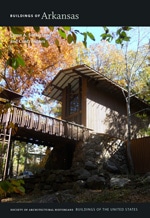Arkansas Tech University was created in 1909 by the Arkansas General Assembly to serve one of four agricultural school districts. The Second District was the northern portion of the state, and Russellville was chosen because of its central location and its convenient access by rail and river. It also helped that Russellville offered a four-hundred-acre tract of land on the edge of the city and a cash bonus of several thousand dollars. The first students were admitted in 1910. The school was renamed the Arkansas Polytechnic College in 1925 and changed to Arkansas Tech University in 1976. Many of the twentieth-century buildings are Colonial Revival in style, notably Wilson Hall (1925), a red brick classroom building, and Caraway Hall (1934), a three-story brick dormitory with a semicircular columned portico designed by A. N. McAninch. The two-story stone Hughes Hall was built from WPA funds in 1940 for classrooms. In the early twenty-first century many new buildings were added to the campus to serve the growing student body. Most of the new buildings employ red brick in order to harmonize with the historic structures, but with more contemporary styling and the use of glass walls. AMR Architects added the four-story Rothwell Hall (2009) and the multiuse Baswell Techionery (2011), which has glass walls sheltered by a roof extension carried on exposed wooden beams.
You are here
Arkansas Tech University (Arkansas Polytechnic College, Second District Agricultural School)
If SAH Archipedia has been useful to you, please consider supporting it.
SAH Archipedia tells the story of the United States through its buildings, landscapes, and cities. This freely available resource empowers the public with authoritative knowledge that deepens their understanding and appreciation of the built environment. But the Society of Architectural Historians, which created SAH Archipedia with University of Virginia Press, needs your support to maintain the high-caliber research, writing, photography, cartography, editing, design, and programming that make SAH Archipedia a trusted online resource available to all who value the history of place, heritage tourism, and learning.















